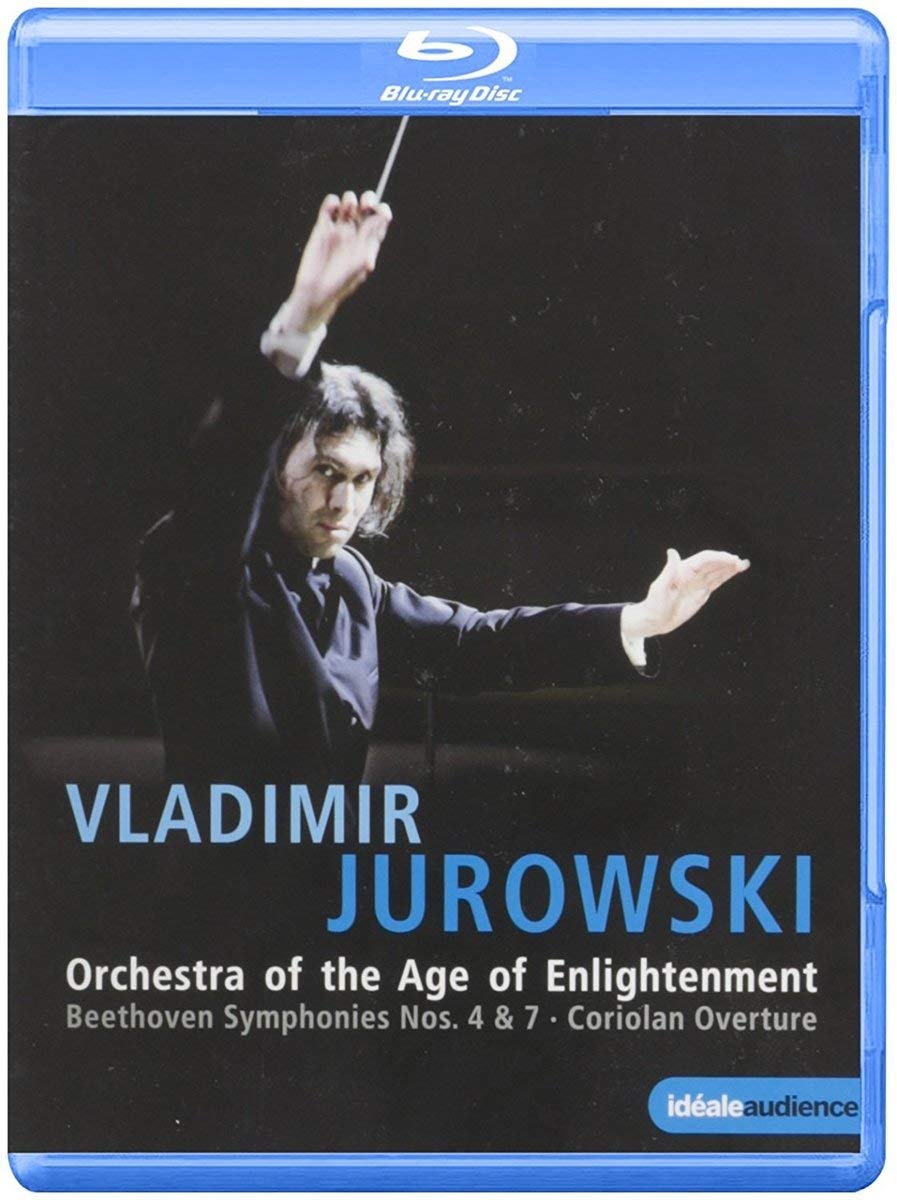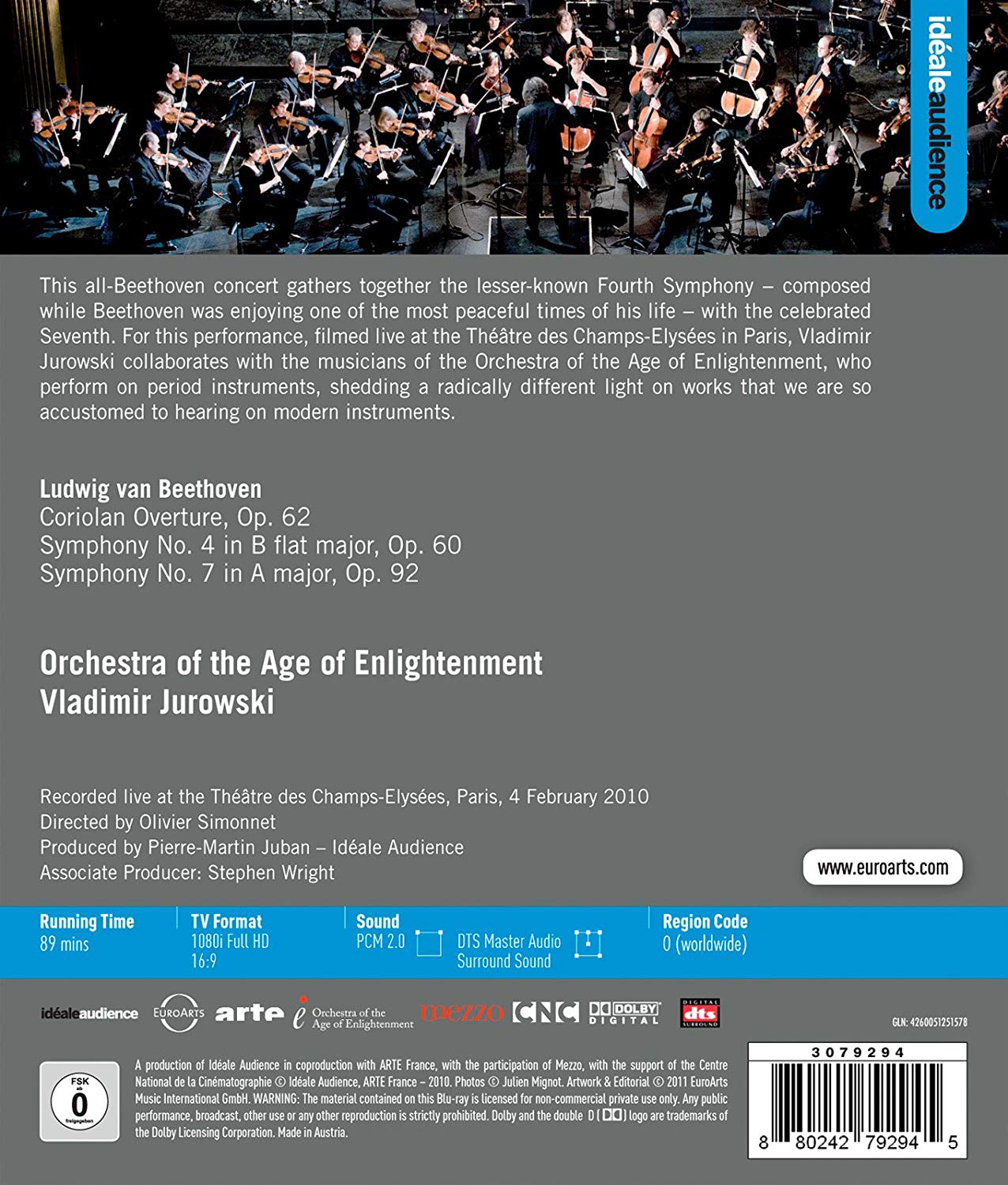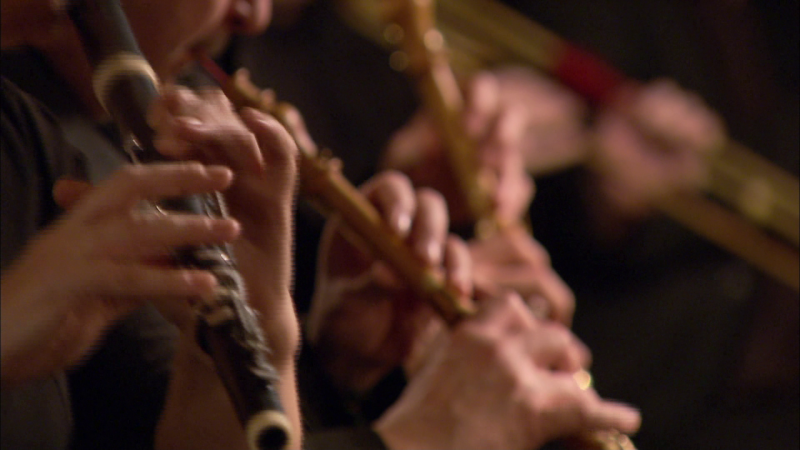

Beethoven Symphony No. 4 and Symphony No. 7. In 2010 Vladmir Jurowski conducts the Orchestra of the Age of Enlightenment at the Théâtre des Champs-Elysées. Program also includes the Coriolan Overture. Directed for TV by Olivier Simonnet. Released 2011, disc has 5.1 dts-HD Master Audio sound. Grade: D+
I know a wealthy man who prefers to drive around in an old pick-up truck rather than in his new Rolls Royce. So I can understand why some folks enjoy the period-instrument sound (flat, thin, lean, clean, and revealing) as an alternate to the modern orchestra. Richard Lawrence in the October 2011 Gramophone reports (page 102) that he saw this on DVD. He loved the music, but suggested that listener "throw a blanket over the screen." I showed this title to the OperaDou Jury in Nîmes as an example of bad video; I was surprised when sophisticated folks on the jury defended the title because they liked the sound and enjoyed seeing those long trumpets and strange horns. So I conclude that the performance and the recording of the music is good. But, alas, the video on this recording is an atrocity that is hard to excuse for a project done in 2010.
The light in the dingy looking Théâtre des Champs-Elysées was dim. The camera crew didn't seem to have a clue what to do. PQ is bad with grainy images and fuzzy resolution throughout. Colors are grayed out at the same time that there is glare on the players' sheet music.
But the real killer is miserable picture content, and this disc might be used to illustrate a lecture on "All the Ways to Violate Huang's Law for a Good HDVD of a Symphony."
I made detailed notes on the opening segment, the Coriolan Overture, which lasts 7:49 minutes. Even though the overture opens the show, there is no shot of the whole orchestra during this number. This violates a basic responsibility of the TV director in HDVD to show the entire orchestra as soon as feasible. This is done so the viewer can see how the orchestra is organized and get ready to enjoy the show. The overture has 30 conductor shots, 20 instrument-only shots, and 6 shots of portions of the orchestra from the rear ("back shots"). So for almost half of the overture, you don't see the face of a single player! I do count 11 nice, coherent shots of solos and sections. The rest of the video is mostly part-section shots with lots of confusing panning around. A huge number of cuts (not including conductor shots) have obvious problems with focus or depth of field of focus. There are even a number of shots where nothing is in focus! You have to step your way through this cut by cut to understand just how bad it is. In total, there are about 118 cuts in less than 8 minutes for about 4 seconds per cut. This blistering pace is adult attention-deficit-hyperactivity-disorder working overtime.
I then made notes on the 1st movement of Symphony No. 4. It's worse. Well over half of the movement is devoted to instrument-only shots (61!), conductor shots (54), and backs. There still is not a single shot showing all the orchestra although there are 7 showing most of it and one really nice shot showing a row of winds. The rest of Symphony No. 4 is more of the same, although slightly less frantic. In the 3rd movement of Symphony No. 4, we finally get a 100% shot of the orchestra. It looks like a DVD or even a VHS image.
Here are some screenshots from the Coriolan Overture and Symphony No. 4. First we have a "backs" shot that opens the Coriolan Overture. Why would one start off a video of a symphony orchestra concert by showing the backs of all the players? I've seen scores, maybe hundreds, of symphony concerts: never once was my seat behind the orchestra:
I'm going to show you how judicious I am by bragging on some good shots now. Here's the concertmaster and some 1st violins in a clear shot that was apparently easy for one of the cameras to frame. (The only problem is we will see this same view about 20 more times.):
This is the shot of the row of winds I mentioned earlier. This is the only shot in the first half of the disc that shows artistic merit:
This is the first whole-orchestra shot on the disc which appears, as mentioned above, in the Third Movement of Symphony No. 4. Now we see the shocking truth: director Simonnet did not have equipment at the theater that could produce a HD picture at this range with the available light:
Here's a typical shot showing lack of depth of field of focus. Of the 5 musicians framed, only 1 is in focus. And that musician is at the extreme left of the picture:
Who is the viewer supposed the look at in the frame below?
And what the heck is going on here? Clue: in the foreground is an out-of-focus view of a viola player:
The next 2 shots are even worse views of the same two objects in the picture immediately above. I'm not kidding you, these repeated mistakes are on the disc they are trying to sell you:
In the foreground is the back of a second violin. In the background is the front of a cello. Why wasn't this edited out? I figure if the editor did his job, Simonnet wouldn't have a video:
In the images we just saw, at least something is in focus. Here are 5 views where nothing is in focus:
This instrument-only shot is easy to make because the timpani are on the end of the row right in front of the camera. So we get this shot over and over again, normally without seeing the player:
Here are 2 more particularly inane instrument-only shots:
The video of Symphony No. 7 is similar to what we have discussed already. But I'll add one screenshot from the end of the 1st movement of Symphony No. 7 that tops everything else we have dredged up in this series:
Summary: So how do we grade an HDVD when the music has considerable merit and the video is worthless? I've checked, and this performance is not available as a music alone on CD or other format. If the video is bad in HDVD, why not consider the DVD? Well, the DVD doesn't have Master Audio sound. So if you have the money, go ahead with the HDVD and turn the display off. I originally gave an "F" grade to this title. But out of respect from music lovers who defended this title for its sound, I'll move the grade up to "D+" which means: don't bother to buy this unless you've got a real good reason.


















